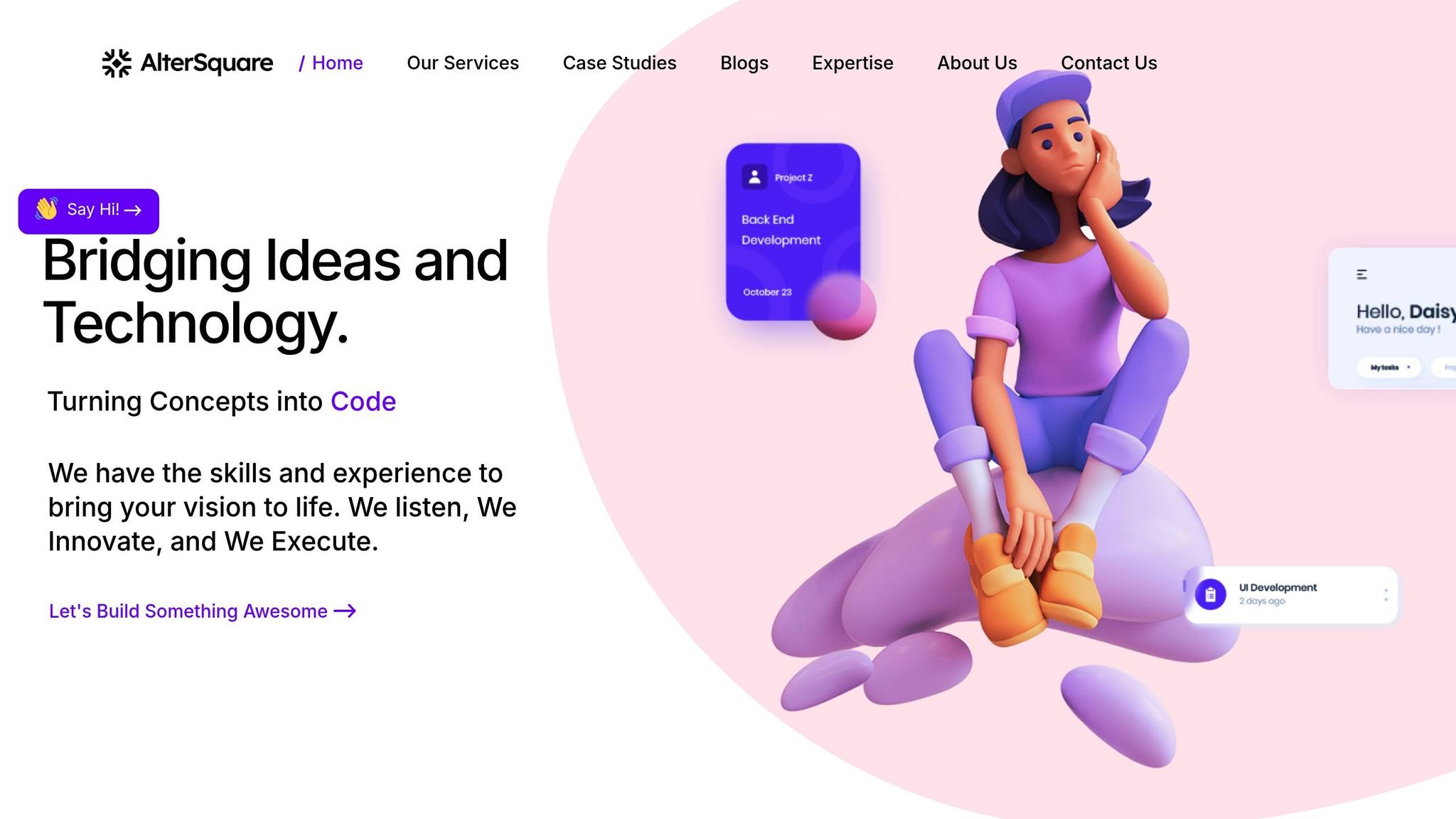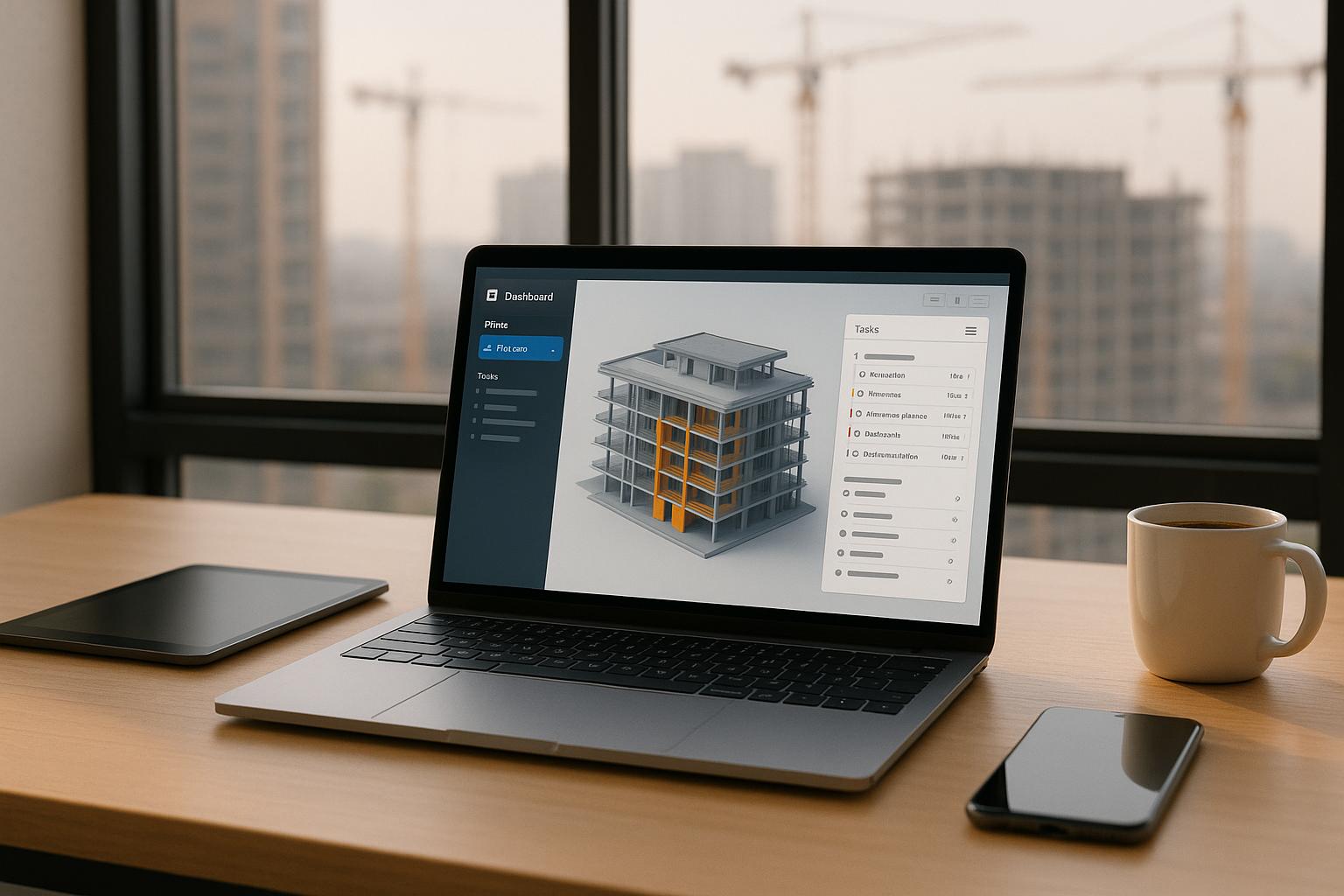Construction Software Architecture: Microservices vs Monolith Performance Test
Taher Pardawala October 6, 2025
Choosing between monolithic and microservices architecture is a critical decision for startups. Here’s the bottom line:
- Monolithic architecture is simpler, faster to build, and cost-effective for early-stage startups with small teams and tight budgets. It works well for straightforward applications but struggles with scalability and flexibility as the system grows.
- Microservices architecture offers scalability and fault isolation, making it ideal for startups with complex needs or rapid growth. However, it adds operational complexity, requires more expertise, and can be expensive to implement.
Key Performance Takeaways:
- Monoliths provide faster response times and lower latency under light loads but face bottlenecks during traffic spikes.
- Microservices handle high-demand scenarios better, allow independent scaling, and support faster updates, but come with network latency and higher costs.
Quick Comparison:
| Criteria | Monolithic Architecture | Microservices Architecture |
|---|---|---|
| Development Speed | Faster for small teams | Slower due to complexity |
| Scalability | Entire system scales together | Independent scaling of services |
| Cost | Lower initial cost | Higher due to infrastructure needs |
| Fault Tolerance | Single point of failure | Isolated service failures |
| Team Size | Suitable for small teams | Better for larger teams |
| Operational Complexity | Easier to manage | Requires advanced tools and expertise |
For early-stage startups: Stick with monoliths to launch quickly and validate your idea.
For growth-stage startups: Consider transitioning to microservices when scaling or flexibility becomes a priority.
Your architecture should align with your business goals, team capabilities, and growth plans.
Monolithic Architecture Performance Analysis
How Monolithic Architecture Works
Monolithic architecture follows a straightforward design: all the components of an application – like the user interface, business logic, and data access layers – are bundled together into a single deployable unit [1]. This setup is similar to how traditional desktop applications operate, where all functionalities run within the same process. Since components communicate through direct function calls, latency is minimal, leading to faster response times. This simplicity makes debugging easier, which is a key advantage for startups launching their first product. For many startups, this speed can significantly accelerate the development and release of a minimum viable product (MVP).
The development process is equally streamlined. With a single codebase and unified technology stack, deployment becomes as simple as packaging everything together. Testing is also more manageable since it involves one cohesive system rather than coordinating multiple independent services.
Monolithic Architecture Advantages
The performance benefits of monolithic systems become evident when speed and efficiency are crucial – especially during the race to launch an MVP. Direct function calls within the same memory space provide the responsiveness needed for applications handling real-time transactions or processing large datasets [2]. For example, WEQ Technologies managed to cut infrastructure costs by 90%, reallocating those savings toward marketing and growth efforts [2].
For small teams, the simplicity of working with one codebase and one deployment process enables rapid development cycles. It’s easier for new developers to understand the entire system, and when issues arise, troubleshooting is less complicated. This fast-paced development environment allows teams to iterate quickly and respond to user feedback without getting bogged down by complex technical setups. Tools like continuous integration pipelines and rollback mechanisms further streamline testing and deployments. However, while these early advantages are significant, they come with scalability challenges, which become more apparent as the system grows.
Scaling Challenges with Monolithic Systems
Despite its initial simplicity, monolithic architecture presents hurdles as the application scales. A major limitation is the inability to scale individual components independently. If one part of the system – like a reporting module – requires more resources, the entire application has to be scaled, leading to inefficient resource allocation and increased costs [1][4].
Another challenge is the impact of even minor updates. Fixing a small bug or adding a feature requires rebuilding and redeploying the entire application, resulting in downtime and slower release cycles. As the codebase grows, the system can become tangled, with interdependent components making it harder to isolate changes. This complexity often leads to coordination issues, such as merge conflicts, especially as more developers join the team [3].
Additionally, the tightly integrated nature of monolithic systems limits flexibility. Adopting new technologies or updating existing ones can be cumbersome, leaving the application stuck with outdated solutions. For startups with limited resources, these scalability and flexibility issues can lead to expensive re-engineering efforts in the future.
Microservices Architecture Performance Analysis
How Microservices Architecture Works
Microservices break down an application into smaller, independent services, each with a specific purpose – like handling authentication or processing payments. These services communicate with one another through standard APIs. Unlike monolithic architectures, where components interact through near-instant direct calls, microservices rely on remote calls. While this design introduces some latency, it allows each service to use the best-suited technology and scale independently.
Typically, each microservice manages its own database, a practice often called "database per service." This separation ensures loose coupling, as services don’t directly access each other’s data. This independence makes it easier to update or evolve individual services without affecting the rest of the system. Services are often containerized using tools like Docker and managed with orchestration platforms like Kubernetes, simplifying deployment and scaling across distributed environments.
Another key benefit is fault isolation. If one service encounters an issue, it doesn’t necessarily disrupt the entire application. Features like circuit breakers and retry mechanisms help maintain stability when individual services fail. This architecture strikes a balance between boosting performance and introducing operational trade-offs.
Microservices Architecture Advantages
Microservices come with clear benefits in terms of performance and flexibility. For example, targeted scaling is possible – services that experience heavy demand, such as payment processing, can scale independently without affecting other parts of the system. This approach also allows development teams to work autonomously, using their preferred tools and deploying updates without needing to coordinate with others.
Fault tolerance is another strength. If one service fails, the rest of the system can continue functioning, which is critical for applications that require high availability, like e-commerce platforms or financial services. Additionally, this architecture accelerates feature delivery since updates can focus on specific services rather than the entire application.
Microservices Complexity and Overhead Issues
Despite its advantages, microservices come with their own set of challenges. The distributed nature of the architecture introduces network latency with every API call, which can slow down real-time applications. Monitoring and debugging become more complex since logs and metrics are spread across multiple services, often requiring advanced (and expensive) tools to manage effectively.
Data consistency is another hurdle. Since each service has its own database, maintaining consistency across distributed transactions can be tricky and demands specialized strategies. Furthermore, teams need to master containerization, service meshes, and API design – skills that come with a steep learning curve. Integration testing also becomes more complicated as it involves coordinating multiple service dependencies.
Understanding these complexities is essential for interpreting the performance results discussed in later sections.
Performance Testing Results: Monolith vs Microservices
Performance Testing Metrics That Matter
When evaluating system architecture, certain performance metrics stand out as essential. Response time measures how quickly your application reacts to user requests, ensuring smooth interactions. Throughput tracks the number of requests your system can handle, especially during peak activity. Then there’s resource utilization – CPU, memory, and network usage – which directly impacts operational costs. Metrics like error rates and latency under load provide insight into system reliability and how it performs under stress. Together, these benchmarks help balance performance with scalability, offering a complete picture of how an architecture handles real-world demands.
Startup-Focused Testing Scenarios
Startup scenarios give a practical look at how different architectures perform. For example, an MVP launch simulation focuses on basic functions like user registration, project creation, and simple data retrieval under moderate user activity. As the system scales, a growth phase test simulates increased concurrent activity, including tasks like file uploads and report generation. To evaluate resilience, traffic spike testing examines how the system handles sudden surges in usage – like during a marketing campaign – revealing its ability to manage unexpected loads. Lastly, feature deployment scenarios assess the impact of rolling out updates or new features, testing whether the architecture can handle changes without causing downtime. These scenarios offer valuable insights into each architecture’s strengths and challenges.
Performance Comparison Summary
The results highlight clear differences between monolithic and microservices architectures. Monolithic systems shine under lighter loads, delivering fast response times and high throughput. However, they can struggle with sudden traffic spikes, leading to potential bottlenecks. On the other hand, microservices architectures handle stress more effectively, managing unexpected surges and recovering faster from localized failures. Their flexibility in deploying updates makes them especially appealing for startups needing to adapt quickly based on user feedback. Ultimately, the right choice depends on your startup’s current needs, growth trajectory, and operational goals – making performance testing a vital step in selecting the best architecture.
sbb-itb-51b9a02
Monolith vs Microservices: Which Architecture WINS in 2025? (Complete Comparison)
Choosing the Right Architecture for Your Startup
When it comes to selecting the right architecture for your startup, raw performance metrics only tell part of the story. Factors like team size, budget, growth plans, and technical needs play a huge role in determining the best path forward. Let’s break down some key architectural options and when they make the most sense.
When Monolithic Architecture Makes Sense
For early-stage startups with limited resources, monolithic architecture often emerges as the go-to choice. If your team consists of just 2–5 developers and you’re racing to get a product to market, working on a single, unified codebase can streamline collaboration and speed up development.
Tight budgets are another reason to consider a monolith. With its simpler setup – usually involving one database, one application server, and basic load balancing – it’s far less expensive to operate compared to more complex architectures. You’ll need fewer servers and less infrastructure, which can be a game-changer for cash-strapped founders.
If your product has straightforward business requirements, a monolith’s simplicity can be a major advantage. For example, if your application has predictable user flows and doesn’t involve intricate integrations or specialized processing, sticking with a monolithic design can save you time and headaches. However, if your startup’s needs become more complex, it might be time to explore the scalability of microservices.
When Microservices Architecture Makes Sense
Scaling startups with complex products often find microservices more suitable as they grow. If your application spans multiple business domains – like user management, payment processing, content delivery, or analytics – microservices allow you to divide and conquer. Each team can focus on a specific service, optimizing it independently without impacting other parts of the system.
For larger development teams, typically 15 or more engineers, microservices can make life easier. Teams can deploy their services independently and even choose technology stacks that best suit their needs. This flexibility also supports faster feature rollouts since isolated services reduce the risk of breaking the entire system during experimentation.
These scenarios highlight when microservices become a natural fit for startups looking to scale efficiently.
How AlterSquare Guides Architecture Decisions

AlterSquare takes a tailored approach to architecture through its I.D.E.A.L. framework, starting with a deep dive into your business context before offering technical recommendations. They don’t believe in one-size-fits-all solutions – instead, they consider your team’s strengths, growth trajectory, and operational limits to suggest the best path forward.
During their 90-day MVP program, AlterSquare often advises early-stage startups to stick with monolithic architecture. This approach prioritizes speed and market validation over premature optimization. They also provide tech stack consultations, helping founders understand the long-term trade-offs of their decisions, including how to plan for future migrations as the business grows.
For growth-stage startups, AlterSquare’s engineering teams assess when transitioning to microservices makes sense. They specialize in phased modernization, gradually extracting critical services from monoliths without disrupting ongoing operations. This step-by-step approach minimizes risks and costs while keeping development on track.
AlterSquare’s application modernization services are particularly helpful for startups dealing with legacy systems or performance bottlenecks. Instead of pushing for a complete system overhaul, they focus on identifying components that could benefit from microservices while keeping stable parts of the monolith intact.
What sets AlterSquare apart is their focus on business-aligned engineering. Their architectural recommendations are always tied to practical goals like boosting revenue, improving user experience, and enhancing operational efficiency. This ensures that every decision supports measurable business outcomes, not just technical preferences.
Key Takeaways and Next Steps
When deciding between monolith and microservices architectures, it’s all about aligning your startup’s current needs with its growth trajectory. Let’s break it down.
Performance and Trade-Off Summary
Monoliths excel in simplicity, offering fast response times and low latency for straightforward applications. They shine when everything can run smoothly on a single server or a small cluster, keeping things easy to manage with minimal operational overhead.
Microservices, on the other hand, provide scalability and fault isolation but come with added complexity and potential latency. When done right, they let you scale specific parts of your application as needed, which can be a game-changer for performance in high-demand areas.
For startups with limited resources, monoliths are a cost-effective choice. They require fewer servers, simpler monitoring, and less specialized DevOps expertise. Microservices, however, demand a more advanced infrastructure, container orchestration, and expertise in distributed systems – making them a bigger investment in terms of both money and time.
Small teams often benefit from the straightforward nature of monoliths, while larger teams can take advantage of the parallel development opportunities that microservices enable. Ultimately, the choice between the two should be guided by your application’s complexity, your team’s size, and your operational priorities.
Decision Framework for Startup Founders
For early-stage startups with tight budgets and small teams, monoliths are often the best way to get to market quickly and validate your business model. They allow you to focus on building and launching without getting bogged down in operational intricacies.
If your application grows and starts to hit performance bottlenecks – or if different parts of your system need to scale independently – it might be time to consider transitioning to microservices. However, keep in mind that this is no small task. Migrating from a monolith to microservices is a complex, time-intensive process that requires careful planning, team training, and investment in new tools [5]. It’s a decision that should only be made when your current architecture is clearly holding you back.
Architecture choices aren’t set in stone. Many successful companies evolve their systems over time. Some start with a monolith and gradually extract services as they scale, while others begin with microservices if their needs demand it. The key is to ensure your choice supports your team’s capabilities and aligns with your growth timeline.
At the end of the day, the most successful startups prioritize solving customer problems. Your architecture should serve your business goals, not act as a roadblock. Whether you stick with a monolith or move to microservices, the focus should always be on enabling growth and delivering value to your users.
FAQs
What should startups consider when choosing between monolithic and microservices architectures?
Startups face a crucial decision when choosing between monolithic and microservices architectures, as each comes with its own set of trade-offs. If your goal is to launch a Minimum Viable Product (MVP) quickly, a monolithic architecture might be the way to go. Why? It’s simpler to build, test, and deploy, requiring fewer resources and less time – perfect for getting your idea off the ground fast.
On the flip side, if your startup is gearing up for long-term growth, microservices could be the better option. This approach enables modular development, letting you scale specific parts of your application independently. But it’s not without challenges. Managing and deploying microservices can get complicated, and it demands more resources upfront.
In the end, the decision boils down to what your startup needs right now versus where you see it heading in the future. Balancing immediate priorities with scalability is key.
What’s the best way for a startup to transition from a monolithic to a microservices architecture without disrupting operations?
When shifting to microservices, it’s essential to start with a thorough evaluation of your current system and lay out a clear migration plan. One effective method is the strangler pattern, where you gradually replace components of the monolith with microservices. Start small – pick a low-risk pilot project to test the new architecture and tackle potential issues early.
Automating your testing and deployment processes is key to maintaining system stability and reducing errors. Keep a close eye on performance metrics, and make sure to regularly update your team on progress to keep everyone aligned. This step-by-step approach minimizes disruptions, gives you room to make adjustments, and ensures your operations keep running smoothly throughout the transition.
What are the long-term risks of using a monolithic architecture for a startup?
When early-stage startups opt for a monolithic architecture, it might seem like a straightforward choice at first. However, as your application grows, this decision can lead to mounting challenges. Scaling becomes more cumbersome, development cycles slow down, and maintenance costs rise, making it harder to stay agile in a fast-changing market.
A monolithic setup can also restrict adaptability, which becomes increasingly important as your team grows or your product evolves. While its simplicity might be appealing in the beginning, the inability to scale effectively can turn into a major roadblock, complicating efforts to introduce new features or keep pace with innovation.








Leave a Reply